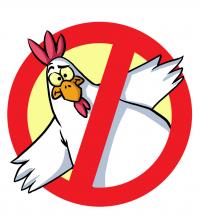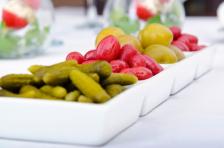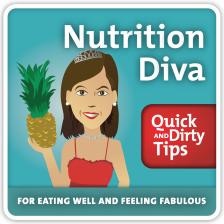How to Cook Vegan
Everyone should have a couple of vegan recipes in their repertoire. Here are some that don’t require any exotic ingredients or techniques.

Or, you might decide to join the millions of American families and institutions that now observe Meatless Monday.
Or, perhaps you’re following Mark Bittman’s advice and eating vegan for breakfast and lunch.
Fortunately, vegan cooking is not as daunting as you may think.
Sponsor: Thanks to Zulily for supporting our channel. Get 15% off your first purchase at zulily.com/diva
What Do Vegans Eat?
Vegans do not eat any animal products whatsoever – eschewing not just meat, poultry, and fish but also eggs, dairy, and even honey. Full-time vegans (and vegan restaurants) often make extensive use of what I think of as analogues – vegan versions of non-vegan foods. At most well-stocked grocery stores, you can buy chorizo made out of tofu, canned “tuna” made from pea protein, a dozen different nondairy milks, yogurts, and cheeses, and egg replacers made from potato and tapioca starch.
There are also a few tricks you can use at home: You can blend raw cashews with ice water to make something that looks like whipped cream. Nutritional yeast can substitute for parmesan cheese. You can use chia seeds to make vegan pudding and jello.
Click here to watch a video of some easy chia pudding recipes.

For example, although it wasn’t really intentional, about a third of the recipes included in my book, Nutrition Diva’s Secrets for a Healthy Diet, turn out to be vegan. Another quarter could be made vegan by swapping out a single ingredient, such as using vegetable stock instead of chicken stock or agave nectar instead of honey. My point is that cooking for vegans needn’t be daunting or intimidating.
What to Serve Vegans (and Others)
There’s no need to buy a bunch of unfamiliar foods, retool recipes, or take a crash course in tofu just because you have a vegan coming for dinner. With a little creativity, you can serve a delicious vegan dinner without your non-vegan guests even realizing it! Here are some ideas:
-
Appetizers: Cheese and crackers are obviously out. Instead, serve guacamole, hummus, or eggplant dip with pita triangles or raw vegetables. Skip the queso and stick with salsa fresca and black bean dip with tortilla chips. Also, everybody loves salted nuts.
-
Salads: Chopped eggs, crumbled cheese, and creamy dressings won’t fly, but virtually any combination of raw or cooked vegetables, fruits, beans, grains, seeds, and oil-based dressings are fine. How about roasted beets and watercress with toasted sunflower seeds and a citrus vinaigrette? Or butter lettuce, steamed asparagus, and chopped hazelnuts drizzled with lemon juice and olive oil? Or arugula, shaved fennel and pomegranate seeds with a pomegranate and walnut oil dressing? Or my Asian-Style Broccoli Salad (just substitute a pinch of sugar for the honey).
-
Soup: You don’t need dairy to make a creamy soup! Autumn vegetables like butternut squash, carrots, parsnips, and potatoes can be simmered in water or vegetable stock and pureed to creamy perfection. My recipe for Silken Asparagus Soup, which uses silken tofu for protein (and creamy deliciousness) could be made vegan simply by substituting vegetable stock for the chicken stock. Split pea, black bean, and lentil soups – sans ham, of course – make hearty, vegan-friendly fare. For something light, try a savory miso broth with scallions.
-
Main Course: Here’s the place where the absence of meat may be most obvious, of course. But there’s no need to resort to a Tofurkey – unless you enjoy them. There are plenty of traditional dishes that just happen to be vegan – or so close to vegan that they can easily be made vegan. Pasta with homemade marinara or Arrabbiata sauce, for example. (Just skip the grated cheese.) Two more of my favorite recipes, Penne with Sauteed Chard and Louisiana Red Beans and Rice, both of which just happen to be vegan, are included in Secrets for a Healthy Diet – along with a near-vegan recipe for Sweet Potato and Cauliflower Curry (just leave out the yogurt garnish).
-
Dessert: Cheesecake, ice cream, and creme brulee aren’t going to figure into a vegan menu but one of my favorite desserts will: A decorative platter of dried and fresh fruits, nuts in the shell, candied ginger, and dark chocolate. Or, try my recipe for Cocoa-Chia Pudding.
If you’re the type who likes to scan online recipe sites, most will allow you to filter for dietary considerations, such as veganism. I usually go right to the Indian, Asian, and Middle Eastern recipes, as these cuisines generally have lots of flavorful vegetarian fare.
See also: Ask the Diva: Good Online Recipe Sites?
FYI: Chicken Stock Is NOT Vegan
I once spoke with a restaurant chef who thought that chicken stock was vegetarian as long as all the meat had been strained out.
Believe it or not, I once spoke with a restaurant chef who thought that chicken stock was vegetarian as long as all the meat had been strained out. I’m assuming you would never make that mistake. But here are a few other less obvious ingredients that have no place in a vegan meal, along with suggestions for vegan alternatives:
- Real mayonnaise (instead, look for egg-free mayo)
- Parmesan cheese (try nutritional yeast)
- Gelatin, found in jello, jams, marshmallows, gummy candies (vegan alternatives exist but watch out for excess sugar!)
- Honey (use maple syrup or agave, in moderation)
- Butter (use coconut or olive oil)
- Egg noodles (look for egg-free pasta)
- Bread made with milk, dried milk, whey, or casein (check ingredient lists)
- Lard (check ingredient lists for tortillas and refried beans)
- Orange juice or other foods with added omega-3s (choose non-fortified versions)
If it’s important that a dish be strictly vegan, remember to scan the ingredient list of any condiments or packaged foods – such as bread – for nonvegan ingredients such as casein, rennet, gelatin, and whey, as well as more obvious ones like milk, eggs, cheese, honey, butter, and lard.
 Keep in Touch
Keep in Touch
Even if you’re not a committed vegan, incorporating vegan cuisine into your diet is just another way to enjoy nutritious variety. If you have favorite vegan-friendly recipes or resources to share, feel free to post them in Comments below or on the Nutrition Diva Facebook page.
Vegetarian sign and other images courtesy of Shutterstock.


 Salads: Chopped eggs, crumbled cheese, and creamy dressings won’t fly, but virtually any combination of raw or cooked vegetables, fruits, beans, grains, seeds, and oil-based dressings are fine. How about roasted beets and watercress with toasted sunflower seeds and a citrus vinaigrette? Or butter lettuce, steamed asparagus, and chopped hazelnuts drizzled with lemon juice and olive oil? Or arugula, shaved fennel and pomegranate seeds with a pomegranate and walnut oil dressing?
Salads: Chopped eggs, crumbled cheese, and creamy dressings won’t fly, but virtually any combination of raw or cooked vegetables, fruits, beans, grains, seeds, and oil-based dressings are fine. How about roasted beets and watercress with toasted sunflower seeds and a citrus vinaigrette? Or butter lettuce, steamed asparagus, and chopped hazelnuts drizzled with lemon juice and olive oil? Or arugula, shaved fennel and pomegranate seeds with a pomegranate and walnut oil dressing?  Dessert:
Dessert: Keep in Touch
Keep in Touch



